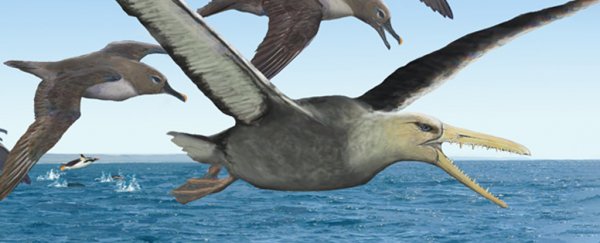Earth's past has served up some super-sized beasties – from mega sharks to giant wombats. Birds are no exception. Palaeontologists have re-discovered a fossil of one of the largest flying avians ever found, tucked away safely in an old museum collection.
"I love going to collections and just finding treasures there," University of California palaeontologist Peter Kloess said.
"Somebody has called me a museum rat, and I take that as a badge of honour. I love scurrying around, finding things that people overlook."
This useful habit led Kloess to search the University of California Museum of Palaeontology collections, where he re-discovered the fossil fragments of an ancient bird, originally retrieved from Seymour Island off the Antarctic Peninsula in the 1980s.
A new analysis of one of the island's sites suggests that the fossil of what was once parts of the bird's foot is actually 10 million years older than initially thought.
It belongs to a 6-metre-winged giant (19 feet), with a bony beak that was jaggedly full of fearsome teeth. This ancient seabird, a type of pelagornithid, soared over southern oceans, much like the albatross of today, for at least 10 million years.
The foot fossil represents the largest known specimen of pelagornithids, which are thought to approach the limit of how big birds can get and still manage to fly. This group emerged to ride sky currents during the Eocene, 60 million years ago, as new life flourished after the mass extinction event that knocked off non-avian dinosaurs.
"Birds evolved to a truly gigantic size relatively quickly after the extinction of the dinosaurs and ruled over the oceans for millions of years," said Kloess.
Only extinct teratorns, ancient vulture relatives, come close to the giant pelagornithid in size, but their wingspan only reached about 4 metres (12 feet). They evolved 40 million years after the pelagornithids went extinct.
Kloess and team also described a 40-million-year-old fossil of a smaller pelagornithid's lower jaw that came from a different site on Seymour Island. They calculated it belonged to a skull up to 60 centimeters (2 feet) long.
 Fragment of fossilised pelagornithid jaw. (Peter Kloess/UC Berkeley)
Fragment of fossilised pelagornithid jaw. (Peter Kloess/UC Berkeley)
Its teeth-like beak protrusions helped the pelagornithids snatch slippery squirming prey from the water. Back then, Antarctica was a relatively toasty warm playground for sloth, marsupial, and penguin ancestors, which would have been a marvel to see.
But "these bony-toothed birds would have been formidable predators that evolved to be at the top of their ecosystem," said palaeontologist Thomas Stidham from the Chinese Academy of Sciences in Beijing.
So, as incredible as this world of giant feathered sky beings sounds, it's probably for the best that we arrived on the scene after they were gone.
This research was published in Scientific Reports.
